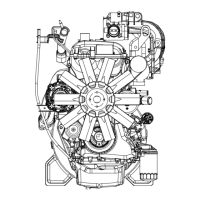DSG-423 GENERAL INFORMATION
01-13
Cylinder Leakage Detection
When a cylinder produces a low reading, use of the
Engine Cylinder Leak Detection/Air Pressurization Kit,
such as the Rotunda Pressurization Kit 014-00705, or
equivalent, will be helpful in pinpointing the exact cause.
The leakage detector is inserted in the spark plug hole,
the piston is brought up to dead center on the
compression stroke, and compressed air is admitted.
Once the combustion chamber is pressurized, a special
gauge included in the kit will read the percentage of
leakage. Leakage exceeding 20 percent is excessive.
While the air pressure is retained in the cylinder, listen
for the hiss of escaping air. A leak at the intake valve will
be heard in the throttle body. A leak at the exhaust valve
can be heard at the tail pipe. Leakage past the piston
rings will be audible at the positive crankcase ventilation
(PCV) connection. If air is passing through a blown
head gasket to an adjacent cylinder, the noise will be
evident at the spark plug hole of the cylinder into which
the air is leaking. Cracks in the cylinder blocks or gasket
leakage into the cooling system may be detected by a
stream of bubbles in the radiator.
Oil Leak and Valve Stem Seal Test
The cylinder leakage detector tests for engine oil leaks
and checks the valve stem seals for leakage.
1. Plug all crankcase openings except the one used for
connecting the leakage detector.
2. Connect the Engine Cylinder Leak Detection/Air
Pressurization Kit to a crankcase opening (an oil
level indicator tube is convenient). Adjust the air
pressure to approximately 34 kPa (5 psi).
3. Using a solution of liquid soap and water, brush the
solution along the gasket sealing surfaces and
bearing seals. Look for bubbles or foam.
4. Remove the spark plugs and rotate the crankshaft
slowly with a wrench. Check for large amounts of air
escaping into the cylinders as each intake valve and
exhaust valve opens.
5. The spark plugs on the leaking cylinders will
probably show deposits of burned oil.
Intake Manifold Vacuum Test
Bring the engine to normal operating temperature.
Connect a Vacuum/Pressure Tester, such as Rotunda
Vacuum/Pressure Tester 059-00008 or equivalent, to
the intake manifold. Run the engine at the specified idle
speed.
The vacuum gauge should read between 51-74 kPa
(15-22 in-Hg) depending upon the engine condition and
the altitude at which the test is performed. Subtract 5.5
kPa (1 in-Hg) from the specified reading for every 500
meters (1,000 feet) of elevation above sea level.
The reading should be quite steady. If necessary, adjust
the gauge damper control (where used) if the needle is
fluttering rapidly. Adjust the damper until the needle
moves easily without excessive flutter.
Rotunda Pressurization
Kit 014-00705
Vacuum Pressure
Tester
059-00008

